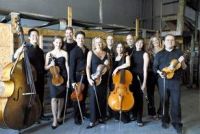February 3, 2009
Concert::Nova Does It in the Dark
There were no hallucinations at Monday evening’s “Concert in the Dark” at the Contemporary Arts Center.
For that, the chamber group Concert:Nova may need to perform in Mammoth Cave or nearby Carter Caves in Kentucky. There it is possible – and routinely done as part of visits to the caves -- to extinguish all light and be in profound darkness. (It is well recognized that deprivation of one sense, such as sight or hearing, tends to sharpen the others.)
Still, the performance in the CAC’s “black box” Performance Space gave its listeners an idea of what that experience might be like. Cincinnati neuro-scientist Christopher Brubaker enlightened the audience with a lecture on music and the brain, which he interspersed among the five works on the program.
They were: Handel/Halvorsen’s Passacaglia for Violin and Viola; Bach’s Brandenburg Concerto No. 4; Charles Koechlin’s Sonata for Two Flutes, Op. 75; “Fratres” for String Quartet by Arvo Pärt; and “Last Round” by Osvaldo Golijov.
C:N performers included violinist/violist Mauricio Aguiar, violinists Eric Bates, Tatiana Berman-Järvi and Anna Reider, violists Heidi Yenney and Joanne Wojtowicz, cellists Theodore Nelson and Susan Marshall-Petersen, bassist Skip Edwards and flutists Randolph Bowman and Jasmine Choi.
Logistics were tricky, even in the lower level CAC Performance Space. The musicians performed behind a black screen and used stand lights with blue gel filters to read their music (performing from memory would have been the impractical alternative).
There was ambient light in the room and one’s eyes quickly adjusted to it so that there was never a feeling of losing one’s bearings. One could listen with closed eyes, but this does not fool the brain into thinking it is truly dark. Some listeners focused their gaze on the floor or otherwise compensated to achieve the feeling of total darkness.
For this listener, the feeling was of being offstage at a concert. To demonstrate the true effect of the experience -- dark vs. light, seeing the performers vs. just hearing them -- the screen was taken down after Golijov’s “Last Round,” which was then repeated with the musicians in full view.
This is what drove the experiment home. “Last Round” is an elegy for Argentine composer Astor Piazzolla, who took the tango from the bordello to the concert hall with his many tango-inspired compositions. It is a kind of simulated bandoneon, the accordion-like instrument closely associated with the tango. There were squeeze-box sounds, much skittering by a double string quartet and tango rhythms galore. To actually see the players perform this evocative music multiplied its impact many fold, suggesting that visual stimulus plays an important role in the emotional aspect of music.
It also emphasized what most music-lovers already know: that there is nothing like a live performance, where the eyes as well as the ears can be drawn into the experience, and why having the right venue for a concert is so important.
In his remarks, Brubaker explained how the brain perceives music, from its reception in the ear to its transmission to the brain and how it is processed. Unlike sight, there is no single music center in the brain, he said. Pitch, timbre (color), melody, harmony and rhythm involve different brain centers, which also differ in location and degree between musicians and non-musicians.
Music's effect on the emotions is more mysterious, he said, but brain scans of people listening to music that gives them chills clearly show that it activates the same pleasure pathways as drugs, food and sex.
He also explained that unfamiliar music can prompt the “fight or flight” response and referred to the famous riot that accompanied the world premiere of Stravinsky’s revolutionary “Rite of Spring” in Paris in 1913. (After it became "familiar" -- a very short time after the premiere -- it was received with adulation and went on to become one of the century’s most popular works.)
C:N artistic director Ixi Chen says that with brain science such an important field of research right now, she would like to make “Concert in the Dark” an annual event.
Perhaps a run out to Carter Caves is in order?

No comments:
Post a Comment